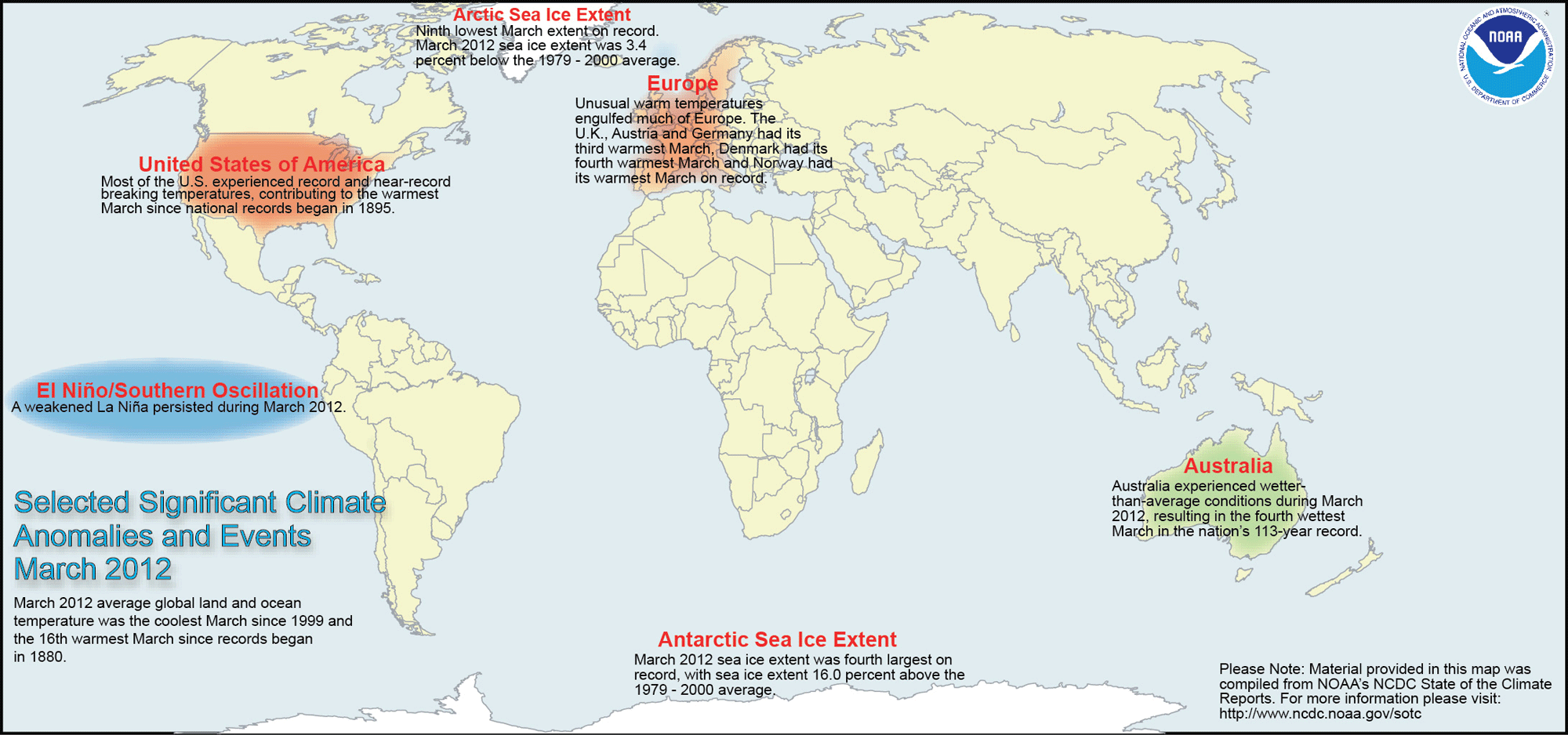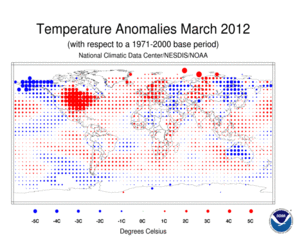March global temperatures were coolest since 1999
Month ranks 16th warmest March for globe; La Niña expected to dissipate by the end of April
The average global temperature for March 2012 made it the coolest March since 1999, yet the 16th warmest since record keeping began in 1880. Arctic sea ice extent during the month was below average but was the largest extent since 2008 and one of the largest March extents of the past decade. Additionally, La Niña conditions continued to weaken during March as temperatures across the equatorial Pacific Ocean warmed during the last two months. According to NOAA’s Climate Prediction Center, La Niña is expected to dissipate by the end of April 2012.
Global temperature highlights: March
- The combined average temperature over global land and ocean surfaces for March 2012 was the 16th warmest March record and the coolest since 1999 at 55.73°F (13.16°C), which is 0.83°F (0.46°C) above the 20th century average of 54.9°F (12.7°C). The margin of error associated with this temperature is ±0.13°F (0.07°C).
- The global land-only surface temperature was 1.31°F (0.73°C) above the 20th century average of 40.8°F (5.0°C), making it the 18th warmest March on record and the coolest global land-only March temperature anomaly since 2003. The margin of error is ±0.23°F (0.13°C).
- Warmer-than-average conditions occurred across nearly all of Canada, the contiguous United States, Mexico, Europe, Argentina, Peru, and parts of northern and central Russia, India, China, and eastern Brazil. Cooler-than-average regions included Alaska, Australia, eastern and western Russia, and parts of New Zealand.
- Norway experienced its warmest March since national records began in 1900, while Australia had its third coolest March maximum temperature since national temperature records began in 1950.
- The United States also experienced its warmest March, with more than 15,000 warm temperature records broken and the average temperature of the lower 48 states being 51.1°F, 8.6°F above the 20th century average for March.
- For the ocean, the March global sea surface temperature was 0.63°F (0.35°C) above the 20th century average of 60.7°F (15.9°C), tying with 1988 and 1990 as the 14th warmest March on record and coolest since 2008. The margin of error is ±0.07°F (0.04°C). The warmth was most pronounced across the north central Pacific, the North Atlantic, much of the eastern Indian Ocean, and portions of the mid-latitude Southern oceans.
Global temperature highlights: Year to date
- The combined global land and ocean average surface temperature for the first three months of the year (January–March) period was 0.70°F (0.39°C) above the 20th century average of 54.1°F (12.3°C), tying with 1991 as the 21st warmest such period on record and the coolest since 1996. The margin of error is ±0.16°F (0.09°C).
- The January–March worldwide land surface temperature was 0.95°F (0.53°C) above the 20th century average of 38.5°F (3.7°C), the 27th warmest such period on record and the coolest since 1996. The margin of error is ±0.40°F (0.22°C). The global ocean surface temperature for the year to date was 0.61°F (0.34°C) above the 20th century average of 60.6°F (15.9°C), tying with 1995 as the 14th warmest such period on record and the coolest since 2008. The margin of error is ±0.07°F (0.04°C).
Polar sea ice and precipitation highlights
- The average Arctic sea ice extent during March 2012 was 3.4 percent below average, ranking ninth smallest March extent since satellite records began in 1979. This is the largest March Arctic sea ice extent since 2008 and one of the largest March extents of the past decade. Arctic sea ice reached its annual maximum extent on March 18th, 12 days later than average.
- On the opposite pole, Antarctic sea ice during March was 16.0 percent above average and ranked fourth largest March extent in the 34-year period of record.
- The Northern Hemisphere snow cover extent during March 2012 was near the long-term average for March, with variability between North American and Eurasia. The North American snow cover extent was much below average, ranking as fourth smallest March snow extent on record. Eurasian snow cover for March was 1.1 million square km above average, or the ninth largest March snow extent.
- Precipitation varied across the globe during March. Dryness prevailed across much of Europe during March. Germany reported its third driest March since national records began in 1881 and Spain reported its driest March since 1997. Other areas that had significant below-average precipitation included eastern Brazil, the eastern United States, southern South America, parts of western and southeastern Africa, and southern and southeastern Asia. Rainfall was much heavier than average across Australia, resulting in the fourth wettest March in the nation’s 113-year record. This rainfall was associated in part with La Niña.
NOAA has the original article













